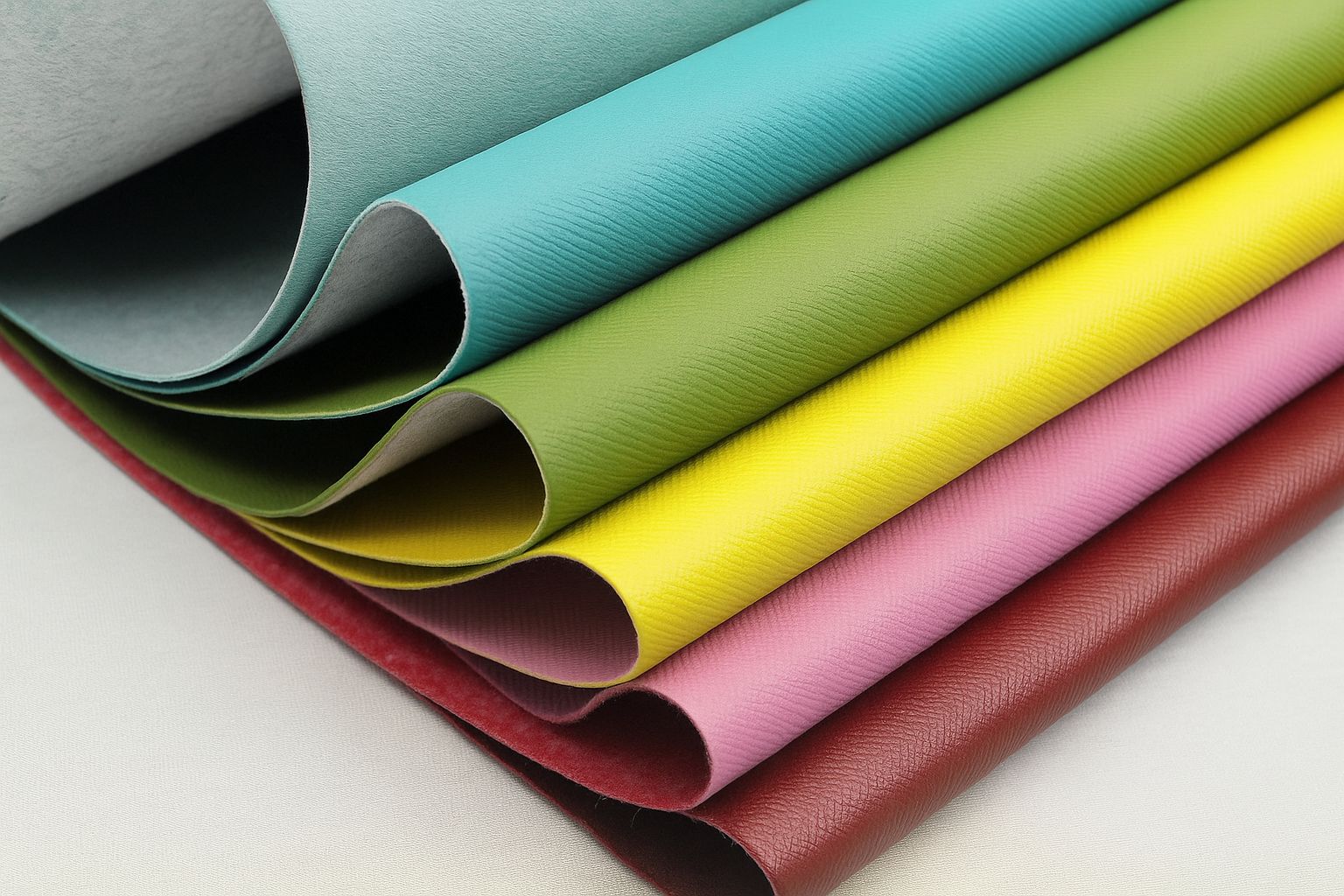PU leather is a man-made material made by coating a fabric backing with polyurethane. It can look and feel like leather, costs less, and is available in many finishes.
PU leather’s often used for custom beach bags, jackets, hats, and stuff like that.
This guide, you will learn how PU leather is made, where it shines, its tradeoffs, how it compares with genuine leather and PVC, what to check before you buy, and how to care for it.
What PU Leather Is
PU leather (polyurethane leather) is a synthetic leather. It is made by applying layers of polyurethane to a textile backing such as polyester, cotton, or microfiber. It contains no animal hide.
Many brands market it as vegan leather, though the term vegan refers only to the absence of animal content, not overall environmental impact.
Thermoplastic polyurethanes can be tuned for hardness, abrasion resistance, and elasticity by adjusting the polymer chemistry, which is why PU leather can mimic different grades of real leather.

How PU Leather Is Made
Most PU synthetic leather uses one of two processes:
Wet process: The backing fabric is saturated with a polyurethane solution, often using a solvent such as N,N-dimethylformamide (DMF), then coagulated in water baths to form a porous layer with leather-like hand. Residual solvent must be removed and recovered. Worker exposure to DMF is a key risk that industry manages with controls and regulations.
- Dry process: Polyurethane is cast or coated onto release paper and then laminated to the backing. This route can reduce water use and, depending on the setup, lessen solvent loads. Waterborne PU systems are increasingly used to further limit solvent emissions.

Regulatory note: In the EU, DMF (N,N-dimethylformamide) used in some wet PU processes is restricted under REACH Annex XVII to protect worker health, with specific conditions set by Commission Regulation (EU) 2021/2030.
Separately, dimethyl fumarate (DMFu), a biocide previously found in sachets inside shoes and furniture, is banned in consumer products. These are different chemicals, often confused.
Benefits and Tradeoffs for Clothing and Bags
Benefits
Versatile looks: consistent color, grain, and emboss patterns, from matte to high gloss.
Lightweight: often lighter than full-grain leather at the same thickness.
Price-accessible: generally lower cost than genuine leather of similar appearance.
Colorfast options: modern finishes resist staining and dye transfer.
Animal-free content: no animal hide, which suits many brand policies and consumer preferences.
Tradeoffs
Breathability: usually lower than quality natural leather, especially in thicker skins.
Heat and UV aging: polyurethane can degrade with prolonged heat, UV, and humidity; hydrolysis is a known mode of failure if storage and chemistry are not managed.
Repairability: scuffs and peeling are harder to refinish than real leather.
Sustainability profile: depends on chemistry, solvents, energy use, recyclability, and end-of-life. See the section below on safety and sustainability.

Cost and Value
Expect PU leather to be less expensive than full-grain or top-grain leather at similar thickness and finish, and similar to or slightly above PVC depending on spec. Price drivers include:
Resin grade and layer count
Backing type and microfiber content
Finish chemistry (e.g., anti-scratch, anti-yellowing)
Process (waterborne or solventborne; wet vs dry)
Order size, emboss plate setup, and color development
Rather than chasing the lowest unit price, weigh total value: durability scores, warranty terms, and color continuity matter more for custom programs.
PU vs Genuine Leather vs PVC
PU Leather (Polyurethane)
Durability: PU leather is durable when well formulated but can degrade with prolonged exposure to heat, UV light, and humidity. Over time, it may experience hydrolysis (breakdown of the polymer), especially if poorly maintained or stored.
Feel: PU leather can mimic the texture of genuine leather with a consistent appearance, including varying finishes like matte or glossy. However, it may feel less natural than genuine leather, which improves with wear.
Breathability: PU leather is generally less breathable compared to genuine leather, making it less suitable for items that require air circulation (like footwear). However, advancements in manufacturing have improved the permeability in some PU products.
Water Resistance: PU leather offers good water resistance, particularly when treated with a topcoat. This makes it suitable for outdoor gear and accessories but still prone to damage under long-term exposure to water without proper care.
Sustainability: The sustainability of PU leather depends on the manufacturing process. Waterborne PU is a more eco-friendly option compared to solvent-based PU. However, PU is still a plastic-based material, and its long-term environmental impact, especially after disposal, remains a concern.
Price: PU leather is generally more affordable than genuine leather, offering a cost-effective alternative with a similar aesthetic. However, higher-quality PU leather may come at a premium price.
Common Uses: PU leather is widely used in clothing, bags, footwear, and small accessories. Its versatility in appearance and cost make it an attractive option for many applications.

Genuine Leather
Durability: Genuine leather is known for its long lifespan and durability. With proper care, it can last decades, developing a unique patina and wear characteristics. High-quality leather can withstand abrasions and maintain its integrity for years.
Feel: Genuine leather has a natural texture and feel that improves over time. It is softer and more flexible than synthetic alternatives, developing a patina that adds to its visual appeal.
Breathability: Leather is naturally breathable, allowing air circulation that makes it more comfortable for clothing and footwear, especially in hot or humid climates.
Water Resistance: Genuine leather can resist water to a certain extent, but it is not fully waterproof. When exposed to water, it should be dried properly to prevent staining or degradation.
Sustainability: The sustainability of genuine leather is a complex topic. While leather is a natural material, its environmental impact is significant due to the energy-intensive tanning process and the carbon footprint of livestock farming. Leather can be biodegradable, but concerns around animal welfare and chemical use in tanning persist.
Price: Genuine leather is more expensive than synthetic options due to its durability, sourcing, and tanning process. Higher-quality leather can come with a significant price tag, particularly for premium grades like full-grain leather.
Common Uses: Genuine leather is preferred for luxury bags, footwear, jackets, belts, and other high-end fashion accessories. Its long-lasting qualities and natural beauty make it a top choice for premium products.

PVC (Polyvinyl Chloride)
Durability: PVC is highly durable and resistant to abrasion and wear. It is often used for products that require strong, long-lasting materials. However, its plasticizers may degrade over time, leading to cracking and brittleness.
Feel: PVC can feel rigid and less flexible than leather or PU leather. It tends to have a more plasticky texture and can feel synthetic, which may not be ideal for products that need to feel soft or natural.
Breathability: PVC is non-breathable, making it unsuitable for use in products where air circulation is important. It can trap moisture, which could lead to discomfort when used in clothing or footwear.
Water Resistance: PVC is highly resistant to water, making it an excellent choice for rainwear, umbrellas, and outdoor gear. However, its inability to breathe can result in moisture buildup inside products like bags and shoes.
Sustainability: PVC has a controversial environmental footprint due to the chlorine-based chemistry used in its production and the release of harmful substances during manufacturing and disposal. While it is highly durable, its environmental impact is significant, especially regarding microplastics.
Price: PVC is typically the least expensive option compared to both PU leather and genuine leather, making it a popular choice for budget-friendly products. However, its lower cost is balanced by its environmental concerns and less-natural aesthetic.
Common Uses: PVC is often used in budget-friendly bags, rainwear, upholstery, and furniture. It is also popular for items that require high water resistance but don’t need to mimic the appearance of real leather.

How Modu Fashion Can Help
If you are planning a custom bag or apparel program, we can help you match the right material to your use case.
Material selection: We source PU leathers in multiple thicknesses and grains, including waterborne options.
Performance targets: We work with suppliers to obtain third-party test reports for abrasion, hydrolysis resistance, and colorfastness.
Prototyping and color: We support low-MOQ sampling to help you test hand feel and finish before committing.
Explore custom tote bags at Modu Fashion and tell us about your project needs here:
Contact our team: Click here (If this page differs, use the Contact link in our site header.)
FAQ
Wipe with a damp microfiber cloth and mild soap. Rinse the cloth and wipe again. Air dry away from heat. Do not use bleach, acetone, or oil-based leather conditioners.
Polyurethane can degrade with heat, humidity, and UV over time. Poor storage and lower-grade finishes speed up failure. Proper chemistry and storage slow it down.
New materials may have a light factory odor from finishing. Strong or persistent chemical odors are a red flag
Many PU leathers are well tolerated, but sensitivities vary.
Yes in the sense that it uses no animal hide. Vegan does not automatically mean lower environmental impact. Evaluate chemistry, energy, emissions, and end-of-life when comparing materials.




